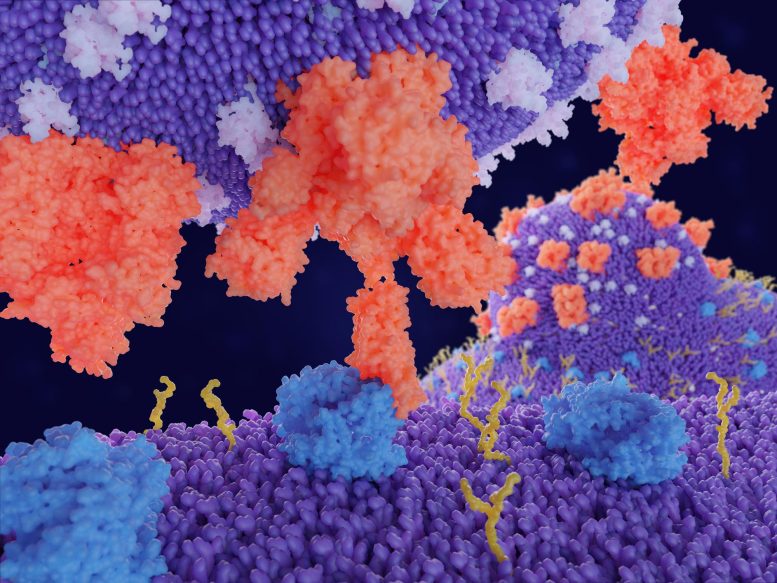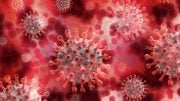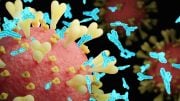
Binding of a SARS-CoV-2 spike protein (red) to an ACE2 receptor (blue) leads to the penetration of the virus into the cell, as depicted in the background. Credit: Juan Gaertner, CC-BY 4.0
Some ancestral rodents likely had repeated infections with SARS-like coronaviruses, leading them to acquire tolerance or resistance to the pathogens, according to new research publishing today (November 18th, 2021) in PLOS Computational Biology by Sean King and Mona Singh of Princeton University, US. This raises the possibility that modern rodents may be reservoirs of SARS-like viruses, the researchers say.
SARS-CoV-2, the virus that causes COVID-19 infection, is of zoonotic origin—it jumped from a non-human animal to humans. Previous research has shown that Chinese Horseshoe bats are a host of numerous SARS-like viruses and tolerate these viruses without extreme symptoms. Identifying other animals that have adapted tolerance mechanisms to coronaviruses is important for awareness of potential viral reservoirs that can spread new pathogens to humans.
In the new research, King and Singh performed an evolutionary analysis, across mammalian species, of the ACE2 receptors, used by SARS viruses to gain entry into mammalian cells. Primates had highly conserved sequences of amino acids in the sites of the ACE2 receptor known to bind SARS viruses. Rodents, however, had a greater diversity — and an accelerated rate of evolution — in these spots. Overall, the results indicated that SARS-like infections have not been evolutionary drivers in primate history, but that some rodent species have likely been exposed to repeated SARS-like coronavirus infections for a considerable evolutionary period.
“Our study suggests that ancestral rodents may have had repeated infections with SARS-like coronaviruses and have acquired some form of tolerance or resistance to SARS-like coronaviruses as a result of these infections,” the authors add. “This raises the tantalizing possibility that some modern rodent species may be asymptomatic carriers of SARS-like coronaviruses, including those that may not have been discovered yet.”
Reference: “Comparative genomic analysis reveals varying levels of mammalian adaptation to coronavirus infections” by King SB, Singh M, 18 November 2021, PLOS Computational Biology.
DOI: 10.1371/journal.pcbi.1009560
Funding: This work has been supported in part by the National Institutes of Health (NIH) R01-GM076275 (to M.S.) and 5T32GM007388 (to Princeton University Department of Molecular Biology). The funders had no role in study design, data collection and analysis, decision to publish, or preparation of the manuscript.









Adopt a domesticated cat.
Rats.
Billions of them on every continent.
China 🇨🇳 is the Rat Capital of the World. Wonder how many there are/were in Wuhan?
Look’s like the Pied Piper of Hamlin wasn’t paid enough.
What do Horseshoe bats eat?
C19 infected rats? Maybe.
Mammals which have been identified as reservoirs for Covid 19 viruses include White tailed 🦌Deer, Horse Shoe Bats, AND Rats.
If Zootonic is main reason for the spread to humans, then close contact with Pets susceptible to the same may be cause of Zeroth infection in Humans. Too difficult to identify root cause in such a scenario where billions of asymptomatic carriers (Rats) who may have been consumed in the animal protein food chain and caused infection to enter the Human Ecosystem vide consumption of animal protein.
All pets also have excretory systems and though they may have developed immunity there excrement may have helped spread the same to humans.
Computational Biology And Computational Chemistry needs to talk to each other to create Computational Biochemistry and Predictive computational Biochemistry , to help avoid future Pandemics .
A network of extremely sensitive sensors and data monitoring and gathering of early warning signals to raise early alarm when probability of Catastrophic Risks also known as black Swan Risks (which are normally a extremely low) , seems
to be heading higher, aa shown by Early Warning System (EWS), and could enable us to take early preventive actions to minimize loss of lives.
What is a mystery is why all the people in the Wuhan Lab perished?
Views expressed are personal and not binding on anyone.
“What is a mystery is why all the people in the Wuhan Lab perished?”
No, what is a mystery is why you believe that! I have seen nothing to support your claim. Can you provide a reputable source to support your claim? If not, then you are just spreading misinformation.
Just to echo, and support the observation of Clyde Spencer, above: I, likewise, have seen no reports of deaths in China’s Wuhan Lab.
There’s enough misinformation re. Covid 19 bouncing around; not to add to it.